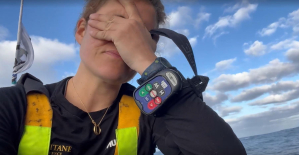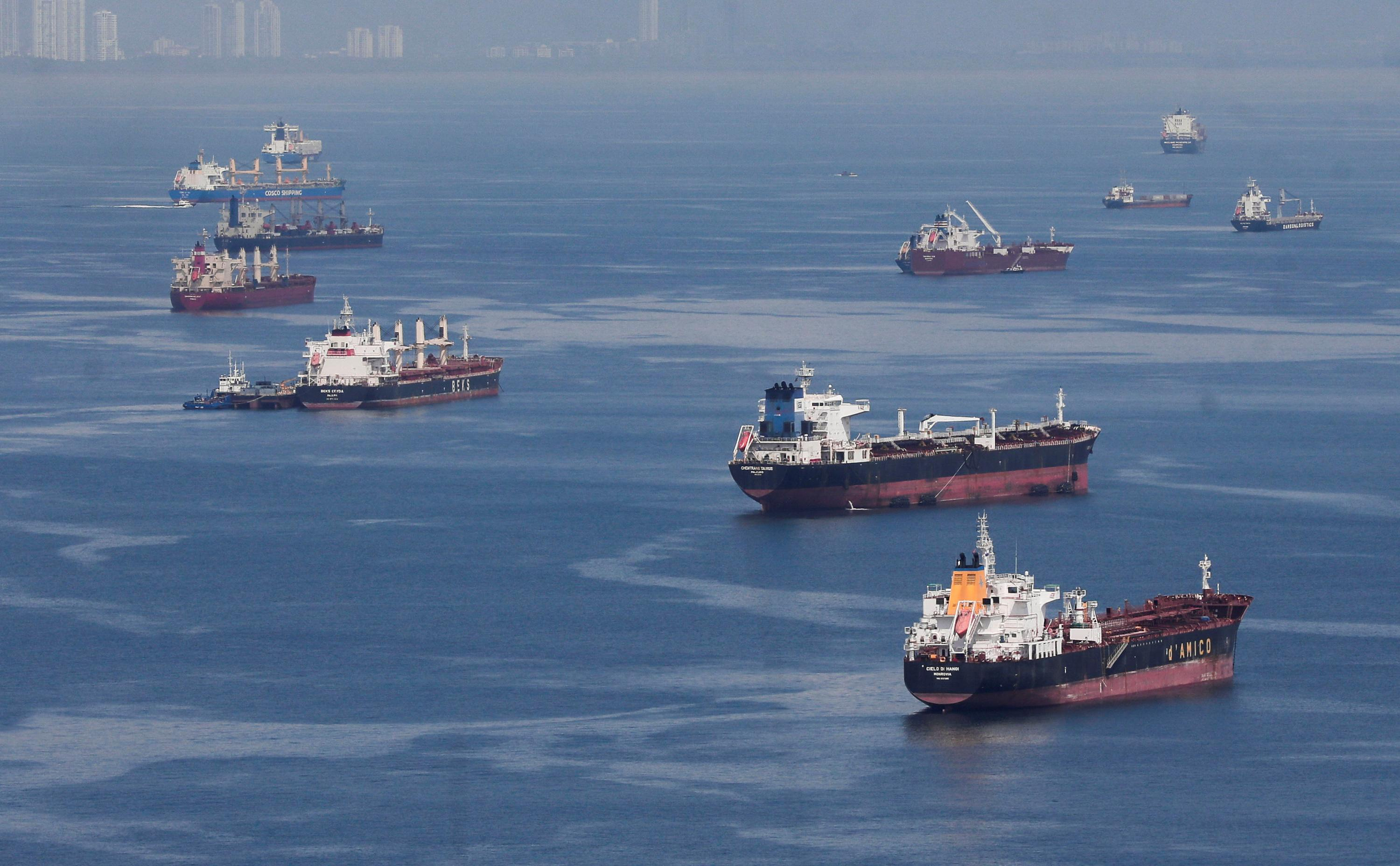When the containers can no longer sail, they take the train. Those of the shipping company Maersk at least. For several weeks, the Danish carrier has had to deal with an almost dry Panama Canal. In response, Maersk declared in a press release published on Thursday that it had “made the decision to use the Panama Canal Railway to protect the supply chains of [its] customers”.
The route between Oceania and cities in the eastern United States will now be divided into three parts. The first will go from Australia or New Zealand to Balboa, a commercial port in southern Panama. The containers will be transferred to trains and then cross the country on rails before being loaded in Colon, a Caribbean port. Then head to the United States, towards the cities of Philadelphia and Charleston. As long as the canal does not return to its usual level, this trick will take place twice a week, the company detailed in a notice for its customers.
Fed by several lakes, the 80-kilometer canal, which has linked the Atlantic Ocean to its big brother in the Pacific since 1913, is facing a historic drought. The Panama Canal Authority (ACP) is particularly concerned about the level of Gatún Lake, the canal's main reservoir, which is abnormally low this season. However, for each boat, it is necessary to discharge nearly 200 million liters of fresh water, which the canal usually obtains from a hydrographic basin formed by lakes.
Without being able to guarantee sufficient water height for heavy cargo ships, the ACP has significantly reduced the number of passages on the canal, lowering it from 40 to 24 boats per day. “We understand that our customers, like us, must adapt their operations due to the impacts of global climate variations and the current water shortage in the Panama Canal,” the authority said in response to the measures taken by Maersk.
Recent weather forecasts do not suggest any improvement. Especially since the drought in Panama depends on El Niño, a meteorological phenomenon which originates in the Pacific and which causes extreme climatic episodes on the American continent for several months.
To remedy these episodes which could occur more and more frequently, the Panamanian government is considering long-term solutions. In addition to the railway line, renovated at the beginning of the 21st century, the ACP is considering building new drinking water reservoirs to supply the passage. The project under study would be built on the Indio River, west of the canal. Its water would be transported through a tunnel of approximately eight kilometers to Lake Gatún. Depending on the abundance of rain, the reservoir could fill in three months, at best, or in two and a half years if the drought continues, warned the canal administrator, Ricaurte Vásquez, in September. Another project is under study to extract water from Bayano Lake, located east of the canal.
In the meantime, cargo ships that want to use the canal must face increasing delays. This Monday, January 15, the average waiting time was more than 16 days to travel from south to north, compared to just over seven days in December.

 What is chloropicrin, the chemical agent that Washington accuses Moscow of using in Ukraine?
What is chloropicrin, the chemical agent that Washington accuses Moscow of using in Ukraine? Poland, big winner of European enlargement
Poland, big winner of European enlargement In Israel, step-by-step negotiations for a ceasefire in the Gaza Strip
In Israel, step-by-step negotiations for a ceasefire in the Gaza Strip BBVA ADRs fall almost 2% on Wall Street
BBVA ADRs fall almost 2% on Wall Street Children born thanks to PMA do not have more cancers than others
Children born thanks to PMA do not have more cancers than others Breast cancer: less than one in two French women follow screening recommendations
Breast cancer: less than one in two French women follow screening recommendations “Dazzling” symptoms, 5,000 deaths per year, non-existent vaccine... What is Lassa fever, a case of which has been identified in Île-de-France?
“Dazzling” symptoms, 5,000 deaths per year, non-existent vaccine... What is Lassa fever, a case of which has been identified in Île-de-France? Sánchez cancels his agenda and considers resigning: "I need to stop and reflect"
Sánchez cancels his agenda and considers resigning: "I need to stop and reflect" “Amazon product tester”: the gendarmerie warns of this new kind of scam
“Amazon product tester”: the gendarmerie warns of this new kind of scam “Unjustified allegations”, “promotion of illicit products”… Half of the influencers controlled in 2023 caught by fraud repression
“Unjustified allegations”, “promotion of illicit products”… Half of the influencers controlled in 2023 caught by fraud repression Extension of the RER E: Gabriel Attal welcomes a “popular” ecology project
Extension of the RER E: Gabriel Attal welcomes a “popular” ecology project WeWork will close 8 of its 20 shared offices in France
WeWork will close 8 of its 20 shared offices in France “We were robbed of this dignity”: Paul Auster’s wife denounces the betrayal of a family friend
“We were robbed of this dignity”: Paul Auster’s wife denounces the betrayal of a family friend A masterclass for parents to fill in their gaps before Taylor Swift concerts
A masterclass for parents to fill in their gaps before Taylor Swift concerts Jean Reno publishes his first novel Emma on May 16
Jean Reno publishes his first novel Emma on May 16 Cannes Film Festival: Meryl Streep awarded an honorary Palme d’Or
Cannes Film Festival: Meryl Streep awarded an honorary Palme d’Or Omoda 7, another Chinese car that could be manufactured in Spain
Omoda 7, another Chinese car that could be manufactured in Spain BYD chooses CA Auto Bank as financial partner in Spain
BYD chooses CA Auto Bank as financial partner in Spain Tesla and Baidu sign key agreement to boost development of autonomous driving
Tesla and Baidu sign key agreement to boost development of autonomous driving Skoda Kodiaq 2024: a 'beast' plug-in hybrid SUV
Skoda Kodiaq 2024: a 'beast' plug-in hybrid SUV The home mortgage firm rises 3.8% in February and the average interest moderates to 3.33%
The home mortgage firm rises 3.8% in February and the average interest moderates to 3.33% This is how housing prices have changed in Spain in the last decade
This is how housing prices have changed in Spain in the last decade The home mortgage firm drops 10% in January and interest soars to 3.46%
The home mortgage firm drops 10% in January and interest soars to 3.46% The jewel of the Rocío de Nagüeles urbanization: a dream villa in Marbella
The jewel of the Rocío de Nagüeles urbanization: a dream villa in Marbella Europeans: a senior official on the National Rally list
Europeans: a senior official on the National Rally list Blockade of Sciences Po: the right denounces a “drift”, the government charges the rebels
Blockade of Sciences Po: the right denounces a “drift”, the government charges the rebels Even on a mission for NATO, the Charles-de-Gaulle remains under French control, Lecornu responds to Mélenchon
Even on a mission for NATO, the Charles-de-Gaulle remains under French control, Lecornu responds to Mélenchon “Deadly Europe”, “economic decline”, immigration… What to remember from Emmanuel Macron’s speech at the Sorbonne
“Deadly Europe”, “economic decline”, immigration… What to remember from Emmanuel Macron’s speech at the Sorbonne These French cities that will boycott the World Cup in Qatar
These French cities that will boycott the World Cup in Qatar Champions Cup: Toulouse with Flament and Kinghorn against Harlequins, Ramos replacing
Champions Cup: Toulouse with Flament and Kinghorn against Harlequins, Ramos replacing Tennis: still injured in the arm, Alcaraz withdraws from the Masters 1000 in Rome
Tennis: still injured in the arm, Alcaraz withdraws from the Masters 1000 in Rome Sailing: “Like a house that threatens to collapse”, Clarisse Crémer exhausted and in tears aboard her damaged boat
Sailing: “Like a house that threatens to collapse”, Clarisse Crémer exhausted and in tears aboard her damaged boat NBA: Patrick Beverley loses his temper and throws balls at Pacers fans
NBA: Patrick Beverley loses his temper and throws balls at Pacers fans


















